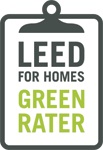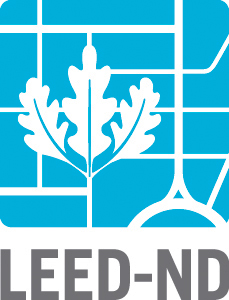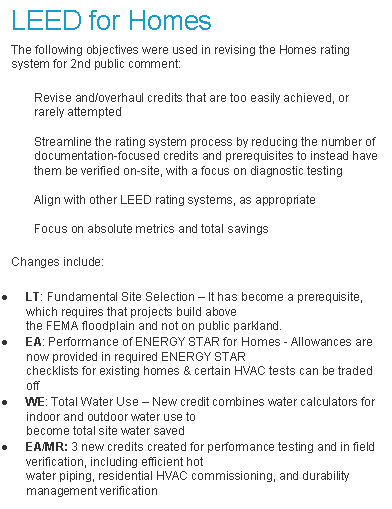Raymar Homes has completed and certified a LEED Gold House in Rockford, Michigan. This video displays visuals of how many points were achieved. Credits appear on the screen that correspond with visual measures of LEED points.


Raymar Homes has completed and certified a LEED Gold House in Rockford, Michigan. This video displays visuals of how many points were achieved. Credits appear on the screen that correspond with visual measures of LEED points.

Jimmie Sparks of the neighborhood Energy Connection in St Paul MN has passed his Green Rater exam and is ready to service the state of Minnesota as a LEED for Homes Green Rater and HERS Rater. If you have a new project or have program questions in that state please contact Jimmie below.

Jimmie Sparks
Residential Energy Program Manager
Neighborhood Energy Connection
624 Selby Ave, St Paul, MN 55104
651-221-4462 x123
www.thenec.org
Area served: Whole state of MN and the western edge of WI.
Other Services: HERS Rater

Just share a few brief thoughts about why you love a local business. Nominate a favorite business yourself if you don’t find it on the list. Only one vote per business, but you can vote for as many businesses as you like.
Each vote is like a raffle ticket.
The more votes a business gets, the more chances they have to win $25,000 Intuit Hiring Grants that are awarded each month.
Your words matter!
Judges will review the monthly grant winners and select one Grand Prize winner of an Intuit Small Business Grant worth $50,000!

Here are a few simple steps that need to be accomplished on any project looking to achieve LEED for Homes certification.
1. Durability evaluation form and checklist.
2. Erosion control. Most of this is a code requirement, but if it isn’t where you are, make sure to do it.
3. No invasive plants. Get the list from your extension service and make sure none get planted on your site.
4. Energy Star. Unless you use the prescriptive path, the house must meet the requirements for the Energy Star Homes program, although it doesn’t actually have to be labeled as such. Until the new LEED for Homes version is released next year, you don’t need to move to Energy Star Version 2.5 or 3, but that will likely be required in late 2012.
5. Framing waste order factor. This calculation has to be done for each project.
6. FSC letter to vendors. Write it and send it out to everyone who sells you wood for the job.
7. Waste management planning and documentation. Check into recycling opportunities and either save all your dump manifests or get monthly reports from you haulers and recyclers.
8. Combustion venting. Doors on all fireplaces and wood stoves, no ventless heaters or fireplaces, and no open-combustion appliances or heaters connected to the living space. This helps to keep you from killing your clients.
9. Basic ventilation. Hire an HVAC contractor who knows his stuff or buy the ASHRAE 62.2 standard, read it and follow it. It’s not that difficult.
10. Manual D duct design. Although this is often a code requirement, it gets neglected. Use the same knowledgeable HVAC contractor, or better yet, hire an independent consultant to design and size the system and then put it out for pricing. Then make sure they do what it says.
11. Radon vents in zone 1. If your building is in a radon hazard area, you have to put the vent system in under the slab or in the crawl space. If you forget, you are in for an expensive surprise at the end of the job.
12. No HVAC in the Garage. Keep the furnace and ducts out of the garage; avoid killing your clients.
13. Operations training. You have to either spend an hour with your client or have an outline for an hour of training and have a written owner’s manual. That’s a good business policy, and the hour you spend with them will probably save you lots of phone calls in the future.
Brought to you by; Carl Seville, GBA Advisor
For more complete details on all LEED for Homes Perquisites, view and download this PDF

The USGBC will be offering a 10% discount on LEED for Homes registration fees effective 8/8/11 for projects that register for both LEED for Homes and LEED for Neighborhood Development. LEED-ND pilot projects can use the discount.
The LEED for Neighborhood Development Rating System integrates the principles of smart growth, urbanism and green building into the first national system for neighborhood design. LEED for Neighborhood Development is a collaboration among USGBC, Congress for the New Urbanism, and theNatural Resources Defense Council.

LEED-ND certification provides independent, third-party verification that a development’s location and design meet accepted high levels of environmentally responsible, sustainable development. For more information on certification and to find other resources, view the Neighborhood Development Resources web page.

It is important that all residential stakeholders comment on the proposed changes to the LEED for Homes rating system. This is your chance to shape the LEED rating system, which is traditionally voted on by a predominantly commercial group. needs you to give feedback and help USGBC balance the need for progress with the realities of implementation to keep this a relevant rating system. These changes are currently slated to take effect in the Fall of 2012. has highlighted specific issues that need your input below:

What version of Energy Star should be used?
Energy Star Version 3 (ESV3) is currently proposed as a perquisite in the LEED 2012 rating system. is concerned that Energy Star Version 3 will cost projects roughly $7,000 more to implement and will not be cost effective. recommends that LEED 2012 use the HERS score as an alternative compliance path for the performance path in EA prerequisites, and reward extra points to those pursing ESV3. Energy Star Version 2 will still be the standard until LEED 2012 goes into full effect, despite Energy Star changes on 1/1/12.
What about LEED for existing homes?
The requirements for ESV3 effectively eliminate any existing home gut rehab projects from obtaining Energy Star certification. If LEED 2012 requires ESV3, then no existing homes will be eligible for LEED certification.
We Need Your Support
encourages all who have interest in residential Green Building to comment on these changes by praising valid changes but also giving constructive criticism to measures that are not feasible in the market. USGBC will take into account strong, defensible, constructive comments that are reinforced with suggestions on exactly how the LEED Rating System should develop.
Below are several links to websites with details on the proposed rating system. We encourage you to review a summary of or the complete details for LEED for Homes 2012 changes. There is a 2012 LEED Webcast to get more information and have your questions answered by USGBC staff. After learning about all the proposed changes, please comment on each credit that is of concern to you.
Update Sept 10th. Other issues included:
1. General
Remove commercial structure and language. Align more closely with familiar LH 2008 structure and language.
Justification: additional complexity will result in a major loss of support infrastructure, and established project teams.
2. LT 5-9
Substantially reduce total number of LT points (i.e., reduce bias towards urban projects; enable more points for non-urban projects)
Justification:80% of new homes are built in non-urban areas. Only 1/3 of completed LH 2008 projects achieved any density credits.
3. EA p1 (EA c1)
Energy performance level should be substantially relaxed for entry level projects (especially market-rate average and large sized homes). Special consideration is needed to address the extremely weak participation (so far) from market rate housing.
Justification:Substantial growth in program will only be achieved if the entry level is defined at a performance level that the market-rate projects consider viable (i.e., cost effective).
4. EA p1: ESH v3
For Prereq, roughly align with ESH v3 only in terms of HERS performance level (i.e. exclude checklists). IMPORTANT: Make this both a prereq AND worth approx 10 EA points. (Note ESH v3 performance levels are not that different from energy performance levels of LH 2008 certified homes.)
Justification:Substantial parts of country will not be able to achieve ESH v3 requirements, partly due to complete void of trained HVAC infrastructure.
5. EA c1: LEED Index (MMBtu)
This proposed energy metric is confusing, complex, unproven, and not implementable (no standards and/or guidelines exist).
Justification:The market has not tolerance for additional complexity. Recent changes in Codes and ESH have overwhelmed the marketplace. Further, it is unprecedented for USGBC to create new national standards, rather than to adopt industry-developed/proven standards.
6. WE c1 (WE c2, WE c3)
Align WE performance and prescriptive path (same # of points in each pathway) – both indoor and outdoor.
Justification:The Prescriptive pathway provides a vital educational component to the LH Rating System – for new green residential projects. These projects are typically unfamiliar with green strategies and upgrade measures. They need to be explicitly in the LHRS.
Public Comment will close on September 14th 2011.

LEED 2012 Homes Webcast Register for the LEED 2012 2nd Public Comment Introduction Webcasts. Free for members!
LEED 2012 Homes Rating System Drafts
Clean Version
Redline Revision Example Version
Summary of Changes
1st PC to 2nd PC
2008 to LEED 2012 2nd PC
LEED 2012 Scorecards
Homes
Homes Mid-Rise
Public Comment
Submit comments on any of the LEED 2012 2nd Public Comment Drafts

Green living and environmental sustainability is proving to be much more than just a recent fad. More and more people are jumping on the environmental bandwagon, which has created more need for professionals within this field. Recently, the American National Standards Institute recognized LEED AP Homes as the “most qualified, educated and influential green-building professionals in the marketplace” (ANSI). Because of the accreditation from ANSI, the demand for LEED certified homes and LEED AP professionals is expected to increase.
Building residential homes to LEED certification has become incredibly popular over the past several years. A 91-unit housing development in Tacoma, Washington was the 10,000 home to be LEED certified. The development was the first federally funded redevelopment project to reach LEED platinum status (10,000th Home). On a more local level, the Kent County chapter of Habitat For Humanity has made the commitment to have every home be LEED Gold certified. This decision is saving the families who reside in these homes an estimated $1000.00 a year on utility bills, making LEED the perfect fit for Habitat For Humanity (HFH LEED Commitment).
For those who are less familiar with LEED certification, they may be left wondering how exactly it benefits themselves, the environment, and their pocketbook. LEED homes reduce allergens and triggers for diseases such as asthma and other chemical sensitivities. LEED certified homes are also built with nontoxic materials, which lower exposures to mold and mildew. LEED homes are environmentally friendly because they use less energy to maintain which reduces pollution from fossil fuel resources. In fact, in a recent report from the Green Home Institute (), LEED homes in the Midwest use an average of 40 percent less energy than conventional homes ( Report). Building a LEED home can reduce utility bills by up to 51 percent and also increase the property value of the home (Why LEED).
For a resident in Minneapolis, choosing to have her home LEED certified was an easy decision. She gave three reasons as to why it was a no-brainer for her:
-Easy to follow instructions in the LEED rating systems manual
-Required green rater visits ensures that the project is meeting the standards of LEED certification
-Utility bills are 65 percent less in the LEED home than in her previous conventional home (LEED Minneapolis).
While it can seem like a daunting task to make sure everything in the home is up to par for LEED certification, the United States Green Building Council is making it a little easier. They recently launched a LEED Home Scoring Tool on their website which will give people an idea as to how close their project is to reaching LEED certification. This tool is available free of charge and can be found on the LEED for Homes website (Home Scoring Tool)
Post By:
Katie Alman is a recent summer Intern at . She is completing her marketing bachelors degree at Grand Valley State University. She currently has interested in promoting healthy and affordable living and green building practices.

More details Here!

Anyone building a Green Home or looking to build to the LEED for Homes standard could certainly benefit from the renewed 2011 energy star tax credits for energy efficiency and renewable energy upgrades.
Take a look!
http://www.energystar.gov/index.cfm?c=tax_credits.tx_index#s1
Also, see other LEED incentives in your area.

One of the key players in the real estate transaction process is the appraiser. Much like a certified green home has a third-party verification, an appraiser provides an independent third-party financial analysis of a home.

However, it’s often difficult for buyers and builders of high-performance green homes to find appraisers that are knowledgeable about the characteristics of the home, can find appropriate sales comps on the Green MLS, and more importantly, who are able to attribute market value based on the home’s performance.
Fortunately this is starting to change. On Earth Day, the Appraisal Institute, a membership and professional development organization for appraisers, announced a call for collaboration to the real estate community. The goal is to facilitate data sharing for others in the financial transaction process (brokers, lenders, mortgage brokers, underwriters, etc). The thinking is that if appraisers can more easily have access to information about a LEED-certified home, that could serve as useful information as a comparable property for another high-performance home that is the subject of a valuation assignment.
An April 28 FoxBusiness.com story discussed how the need for green lending products and proper appraisals is driving a new market niche. The story reached a potential audience of nearly 1.75 million unique online visitors.
To find the best financing for green projects, the article recommended working with brokers, lenders and appraisers who are familiar with energy-efficient products, advising readers to turn to organizations like the Appraisal Institute to find qualified appraisers.
So, what can you do to help the process along? First, make sure the appraiser assigned to your case is trained in green building. And second, help the valuation expert find homes that are comparable to yours. If you know of other homes that have been built in your area to any kind of green building standard or energy rated with third-party verification, let the appraiser know about this. It may not be a great comparable property, but then again, maybe it is.
Encourage your lender to share green education events or open houses so their loan officers and appraisers can learn more about local market activity.
Green builders can also help the real estate community by populating their local databases when available. Even a custom home built-to-suit can be listed on an MLS with a listing time of 1 day if the homeowner is comfortable sharing their price data. This can provide one more data point that will help support local market values.
All this and more will help lead to more data on high-performance green homes, such as LEED-certified, which will allow appraisers to identify appropriate adjustments to market value for green homes.